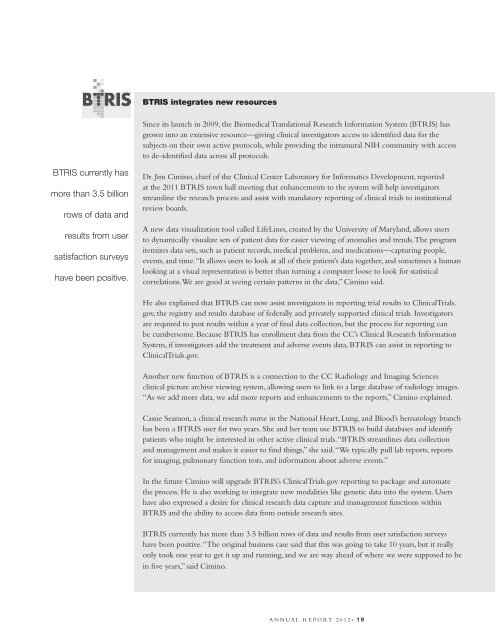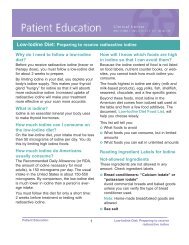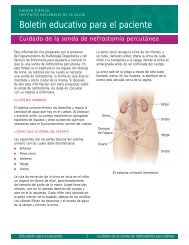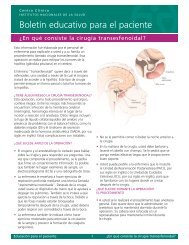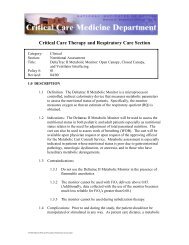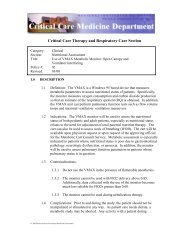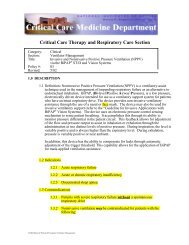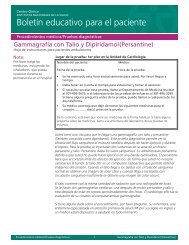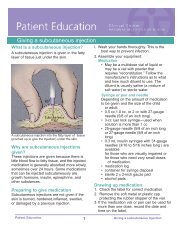NIH Clinical Center Profile 2012 - Search - National Institutes of Health
NIH Clinical Center Profile 2012 - Search - National Institutes of Health
NIH Clinical Center Profile 2012 - Search - National Institutes of Health
You also want an ePaper? Increase the reach of your titles
YUMPU automatically turns print PDFs into web optimized ePapers that Google loves.
BTRIS currently has<br />
more than 3.5 billion<br />
rows <strong>of</strong> data and<br />
results from user<br />
satisfaction surveys<br />
have been positive.<br />
BTRIS integrates new resources<br />
Since its launch in 2009, the Biomedical Translational Research Information System (BTRIS) has<br />
grown into an extensive resource—giving clinical investigators access to identified data for the<br />
subjects on their own active protocols, while providing the intramural <strong>NIH</strong> community with access<br />
to de-identified data across all protocols.<br />
Dr. Jim Cimino, chief <strong>of</strong> the <strong>Clinical</strong> <strong>Center</strong> Laboratory for Informatics Development, reported<br />
at the 2011 BTRIS town hall meeting that enhancements to the system will help investigators<br />
streamline the research process and assist with mandatory reporting <strong>of</strong> clinical trials to institutional<br />
review boards.<br />
A new data visualization tool called LifeLines, created by the University <strong>of</strong> Maryland, allows users<br />
to dynamically visualize sets <strong>of</strong> patient data for easier viewing <strong>of</strong> anomalies and trends. The program<br />
itemizes data sets, such as patient records, medical problems, and medications—capturing people,<br />
events, and time. “It allows users to look at all <strong>of</strong> their patient’s data together, and sometimes a human<br />
looking at a visual representation is better than turning a computer loose to look for statistical<br />
correlations. We are good at seeing certain patterns in the data,” Cimino said.<br />
He also explained that BTRIS can now assist investigators in reporting trial results to <strong>Clinical</strong>Trials.<br />
gov, the registry and results database <strong>of</strong> federally and privately supported clinical trials. Investigators<br />
are required to post results within a year <strong>of</strong> final data collection, but the process for reporting can<br />
be cumbersome. Because BTRIS has enrollment data from the CC’s <strong>Clinical</strong> Research Information<br />
System, if investigators add the treatment and adverse events data, BTRIS can assist in reporting to<br />
<strong>Clinical</strong>Trials.gov.<br />
Another new function <strong>of</strong> BTRIS is a connection to the CC Radiology and Imaging Sciences<br />
clinical picture archive viewing system, allowing users to link to a large database <strong>of</strong> radiology images.<br />
“As we add more data, we add more reports and enhancements to the reports,” Cimino explained.<br />
Cassie Seamon, a clinical research nurse in the <strong>National</strong> Heart, Lung, and Blood’s hematology branch<br />
has been a BTRIS user for two years. She and her team use BTRIS to build databases and identify<br />
patients who might be interested in other active clinical trials. “BTRIS streamlines data collection<br />
and management and makes it easier to find things,” she said. “We typically pull lab reports, reports<br />
for imaging, pulmonary function tests, and information about adverse events.”<br />
In the future Cimino will upgrade BTRIS’s <strong>Clinical</strong>Trials.gov reporting to package and automate<br />
the process. He is also working to integrate new modalities like genetic data into the system. Users<br />
have also expressed a desire for clinical research data capture and management functions within<br />
BTRIS and the ability to access data from outside research sites.<br />
BTRIS currently has more than 3.5 billion rows <strong>of</strong> data and results from user satisfaction surveys<br />
have been positive. “The original business case said that this was going to take 10 years, but it really<br />
only took one year to get it up and running, and we are way ahead <strong>of</strong> where we were supposed to be<br />
in five years,” said Cimino.<br />
A N N U A L R E P O RT 2 0 1 2 • 1 9


